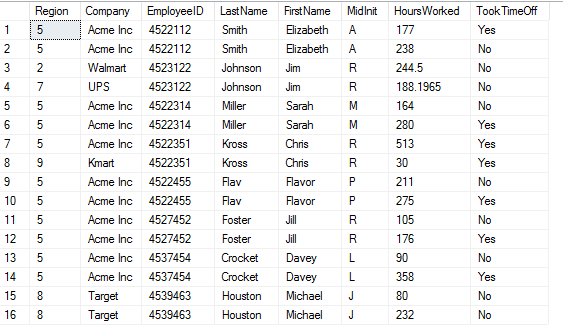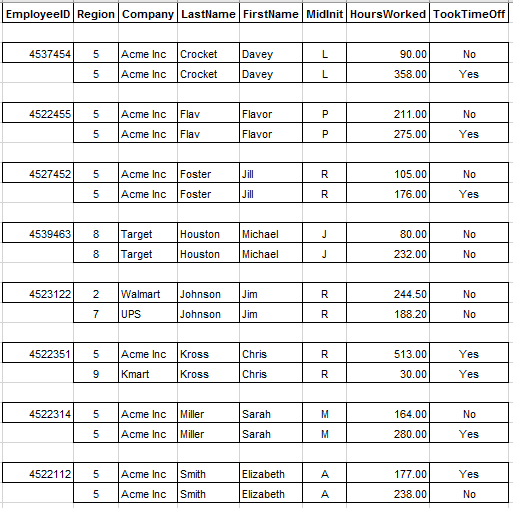maqskywalker
asked on
t-sql group by
I'm using sql server 2008.
I have a table that looks like this:

This is script to create the table:
Order By LastName,FirstName
Then Group the records by EmployeeID.
I created this drawing in excel. This is what I want my result to look like:

What's the best way to get something like that?
I have a table that looks like this:
This is script to create the table:
USE [TestDatabase]
GO
SET ANSI_NULLS ON
GO
SET QUOTED_IDENTIFIER ON
GO
CREATE TABLE [dbo].[TestEmployees2](
[Region] [int] NULL,
[Company] [nvarchar](255) NULL,
[EmployeeID] [int] NULL,
[LastName] [nvarchar](255) NULL,
[FirstName] [nvarchar](255) NULL,
[MidInit] [nvarchar](255) NULL,
[HoursWorked] [float] NULL,
[TookTimeOff] [nvarchar](255) NULL
) ON [PRIMARY]
GO
INSERT [dbo].[TestEmployees2] ([Region], [Company], [EmployeeID], [LastName], [FirstName], [MidInit], [HoursWorked], [TookTimeOff]) VALUES (5, N'Acme Inc', 4522112, N'Smith', N'Elizabeth', N'A', 177, N'Yes')
INSERT [dbo].[TestEmployees2] ([Region], [Company], [EmployeeID], [LastName], [FirstName], [MidInit], [HoursWorked], [TookTimeOff]) VALUES (5, N'Acme Inc', 4522112, N'Smith', N'Elizabeth', N'A', 238, N'No')
INSERT [dbo].[TestEmployees2] ([Region], [Company], [EmployeeID], [LastName], [FirstName], [MidInit], [HoursWorked], [TookTimeOff]) VALUES (2, N'Walmart', 4523122, N'Johnson', N'Jim', N'R', 244.5, N'No')
INSERT [dbo].[TestEmployees2] ([Region], [Company], [EmployeeID], [LastName], [FirstName], [MidInit], [HoursWorked], [TookTimeOff]) VALUES (7, N'UPS', 4523122, N'Johnson', N'Jim', N'R', 188.1965, N'No')
INSERT [dbo].[TestEmployees2] ([Region], [Company], [EmployeeID], [LastName], [FirstName], [MidInit], [HoursWorked], [TookTimeOff]) VALUES (5, N'Acme Inc', 4522314, N'Miller', N'Sarah', N'M', 164, N'No')
INSERT [dbo].[TestEmployees2] ([Region], [Company], [EmployeeID], [LastName], [FirstName], [MidInit], [HoursWorked], [TookTimeOff]) VALUES (5, N'Acme Inc', 4522314, N'Miller', N'Sarah', N'M', 280, N'Yes')
INSERT [dbo].[TestEmployees2] ([Region], [Company], [EmployeeID], [LastName], [FirstName], [MidInit], [HoursWorked], [TookTimeOff]) VALUES (5, N'Acme Inc', 4522351, N'Kross', N'Chris', N'R', 513, N'Yes')
INSERT [dbo].[TestEmployees2] ([Region], [Company], [EmployeeID], [LastName], [FirstName], [MidInit], [HoursWorked], [TookTimeOff]) VALUES (9, N'Kmart', 4522351, N'Kross', N'Chris', N'R', 30, N'Yes')
INSERT [dbo].[TestEmployees2] ([Region], [Company], [EmployeeID], [LastName], [FirstName], [MidInit], [HoursWorked], [TookTimeOff]) VALUES (5, N'Acme Inc', 4522455, N'Flav', N'Flavor', N'P', 211, N'No')
INSERT [dbo].[TestEmployees2] ([Region], [Company], [EmployeeID], [LastName], [FirstName], [MidInit], [HoursWorked], [TookTimeOff]) VALUES (5, N'Acme Inc', 4522455, N'Flav', N'Flavor', N'P', 275, N'Yes')
INSERT [dbo].[TestEmployees2] ([Region], [Company], [EmployeeID], [LastName], [FirstName], [MidInit], [HoursWorked], [TookTimeOff]) VALUES (5, N'Acme Inc', 4527452, N'Foster', N'Jill', N'R', 105, N'No')
INSERT [dbo].[TestEmployees2] ([Region], [Company], [EmployeeID], [LastName], [FirstName], [MidInit], [HoursWorked], [TookTimeOff]) VALUES (5, N'Acme Inc', 4527452, N'Foster', N'Jill', N'R', 176, N'Yes')
INSERT [dbo].[TestEmployees2] ([Region], [Company], [EmployeeID], [LastName], [FirstName], [MidInit], [HoursWorked], [TookTimeOff]) VALUES (5, N'Acme Inc', 4537454, N'Crocket', N'Davey', N'L', 90, N'No')
INSERT [dbo].[TestEmployees2] ([Region], [Company], [EmployeeID], [LastName], [FirstName], [MidInit], [HoursWorked], [TookTimeOff]) VALUES (5, N'Acme Inc', 4537454, N'Crocket', N'Davey', N'L', 358, N'Yes')
INSERT [dbo].[TestEmployees2] ([Region], [Company], [EmployeeID], [LastName], [FirstName], [MidInit], [HoursWorked], [TookTimeOff]) VALUES (8, N'Target', 4539463, N'Houston', N'Michael', N'J', 80, N'No')
INSERT [dbo].[TestEmployees2] ([Region], [Company], [EmployeeID], [LastName], [FirstName], [MidInit], [HoursWorked], [TookTimeOff]) VALUES (8, N'Target', 4539463, N'Houston', N'Michael', N'J', 232, N'No')Order By LastName,FirstName
Then Group the records by EmployeeID.
I created this drawing in excel. This is what I want my result to look like:
What's the best way to get something like that?
SOLUTION
membership
This solution is only available to members.
To access this solution, you must be a member of Experts Exchange.
ASKER CERTIFIED SOLUTION
membership
This solution is only available to members.
To access this solution, you must be a member of Experts Exchange.
The non-cte approach would be create a sub-query as a derived table
select case when rn = 1 then EmployeeID else '' end as EmployeeID
,[Region], [Company], [LastName], [FirstName], [MidInit], [HoursWorked], [TookTimeOff]
from ( select [Region], [Company], cast(employeeid as varchar(10)) as EmployeeID, [LastName], [FirstName], [MidInit], [HoursWorked], [TookTimeOff]
,row_number() over (partition by employeeid order by region,company,LastName,FirstName,HoursWorked) as rn
from TestEmployees2) as SDT
order by [LastName],[FirstName], RNASKER
Thanks for your great info.
If it's all about the EmployeeID not displayed twice, that's not what you prepare in an SQL result, that's a reporting option to suppress repeated values, that's all there is to it.
Bye, Olaf.